BISY2005 Enterprise Systems Report: Business Drivers and Impacts
VerifiedAdded on 2023/01/16
|11
|2472
|68
Report
AI Summary
This report examines the significance of enterprise systems in modern business operations, emphasizing their role in streamlining processes and enhancing efficiency. The report begins with an executive summary, followed by an introduction that highlights the benefits of enterprise systems, such as reduced IT costs and improved data integration. It then delves into the principal drivers behind businesses adopting enterprise systems, including the need for improved safety, cost savings through automation, and better data accessibility. The report explores the scope of these systems, including customer relationship management (CRM), supply chain management, and enterprise resource planning (ERP), and discusses their impact on organizational performance, measuring KPIs like productivity and customer satisfaction. Furthermore, it addresses the organizational changes required for successful enterprise system implementation, including creating project teams, management development, and change management strategies. The conclusion emphasizes the importance of selecting the right system and implementing measures to ensure its smooth operation and future benefits. The report also includes a comprehensive bibliography.

Student’s Last Name 1
Enterprise System
By (Name)
Course
Professor
University
Date
Enterprise System
By (Name)
Course
Professor
University
Date
Paraphrase This Document
Need a fresh take? Get an instant paraphrase of this document with our AI Paraphraser
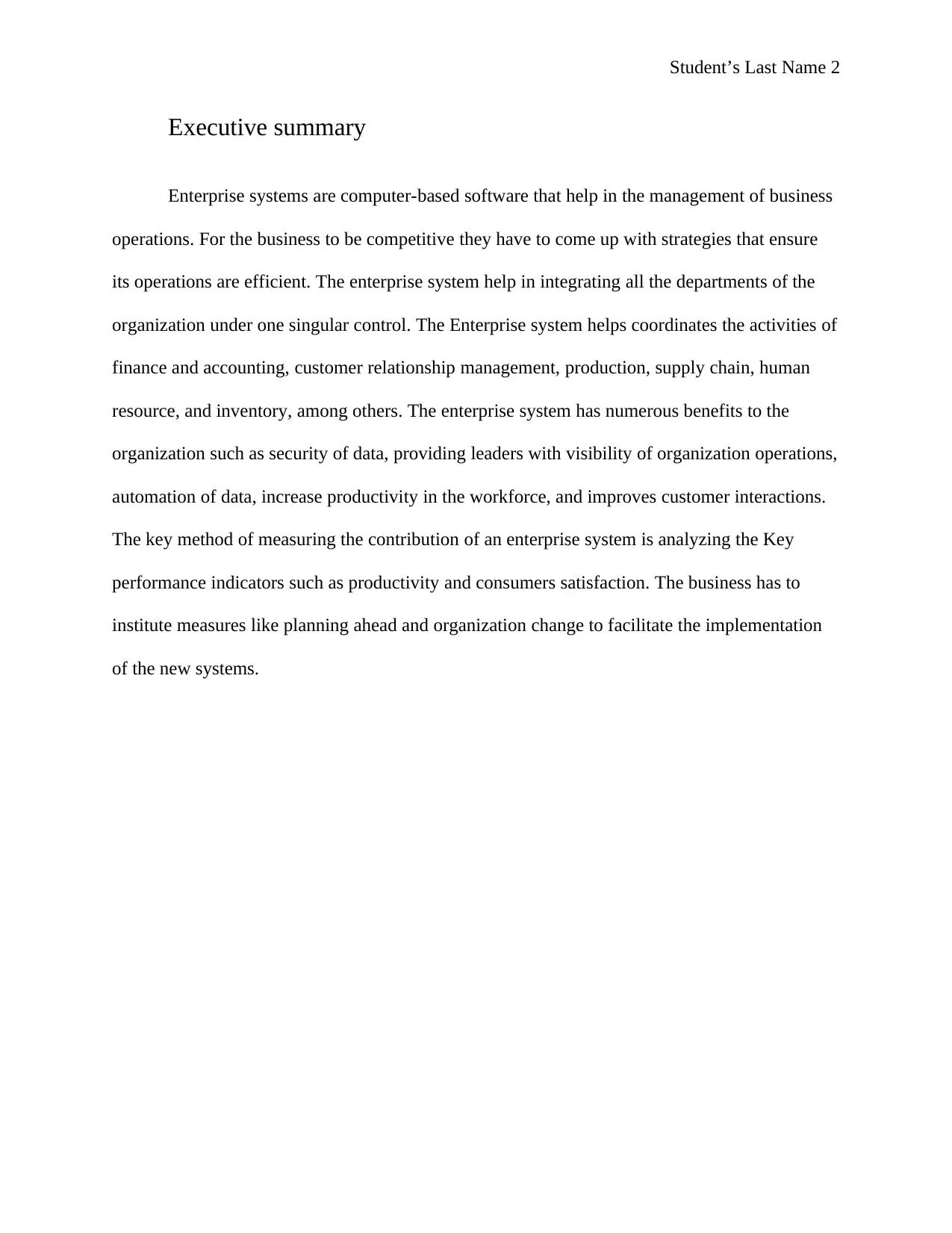
Student’s Last Name 2
Executive summary
Enterprise systems are computer-based software that help in the management of business
operations. For the business to be competitive they have to come up with strategies that ensure
its operations are efficient. The enterprise system help in integrating all the departments of the
organization under one singular control. The Enterprise system helps coordinates the activities of
finance and accounting, customer relationship management, production, supply chain, human
resource, and inventory, among others. The enterprise system has numerous benefits to the
organization such as security of data, providing leaders with visibility of organization operations,
automation of data, increase productivity in the workforce, and improves customer interactions.
The key method of measuring the contribution of an enterprise system is analyzing the Key
performance indicators such as productivity and consumers satisfaction. The business has to
institute measures like planning ahead and organization change to facilitate the implementation
of the new systems.
Executive summary
Enterprise systems are computer-based software that help in the management of business
operations. For the business to be competitive they have to come up with strategies that ensure
its operations are efficient. The enterprise system help in integrating all the departments of the
organization under one singular control. The Enterprise system helps coordinates the activities of
finance and accounting, customer relationship management, production, supply chain, human
resource, and inventory, among others. The enterprise system has numerous benefits to the
organization such as security of data, providing leaders with visibility of organization operations,
automation of data, increase productivity in the workforce, and improves customer interactions.
The key method of measuring the contribution of an enterprise system is analyzing the Key
performance indicators such as productivity and consumers satisfaction. The business has to
institute measures like planning ahead and organization change to facilitate the implementation
of the new systems.
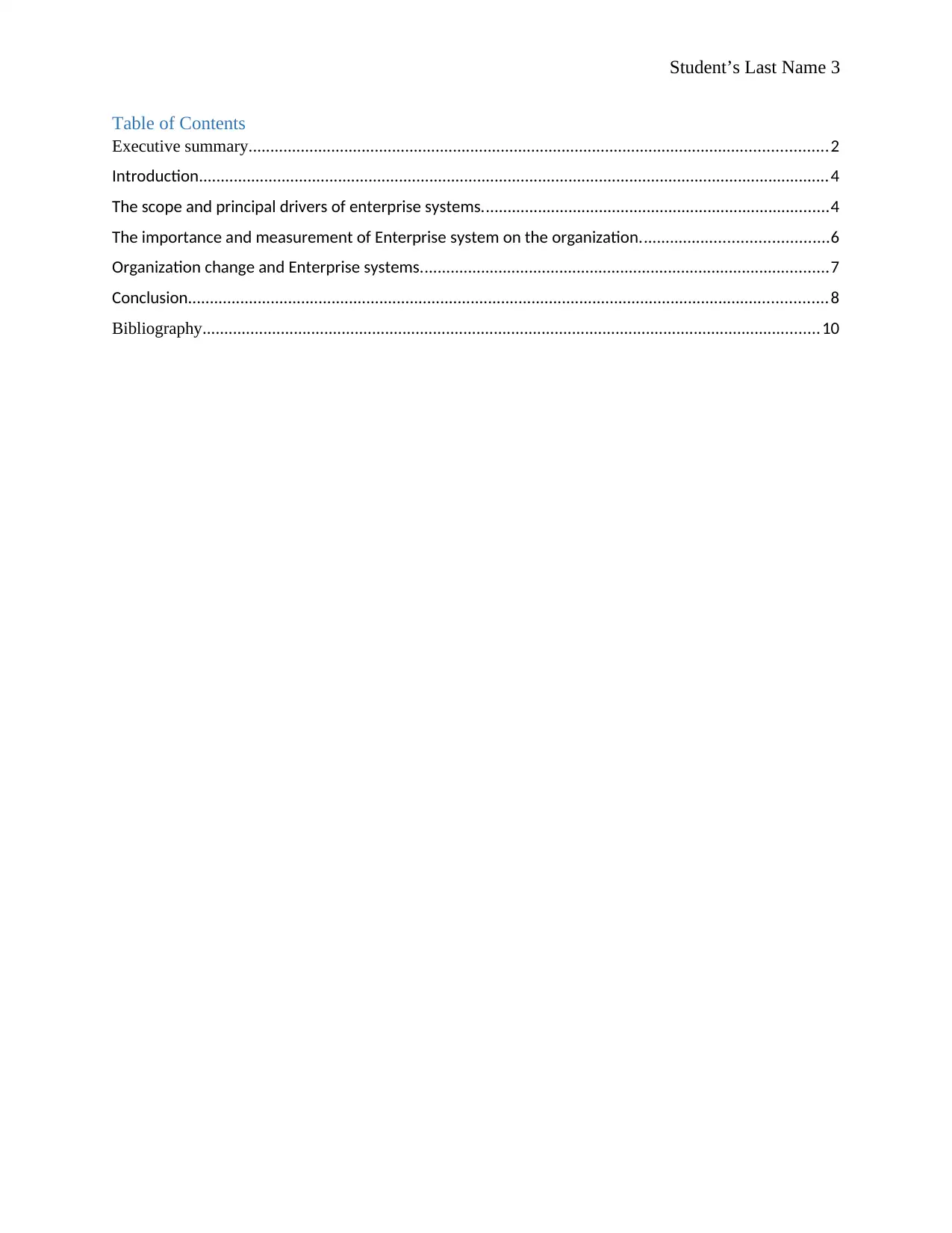
Student’s Last Name 3
Table of Contents
Executive summary.....................................................................................................................................2
Introduction.................................................................................................................................................4
The scope and principal drivers of enterprise systems................................................................................4
The importance and measurement of Enterprise system on the organization...........................................6
Organization change and Enterprise systems..............................................................................................7
Conclusion...................................................................................................................................................8
Bibliography..............................................................................................................................................10
Table of Contents
Executive summary.....................................................................................................................................2
Introduction.................................................................................................................................................4
The scope and principal drivers of enterprise systems................................................................................4
The importance and measurement of Enterprise system on the organization...........................................6
Organization change and Enterprise systems..............................................................................................7
Conclusion...................................................................................................................................................8
Bibliography..............................................................................................................................................10
⊘ This is a preview!⊘
Do you want full access?
Subscribe today to unlock all pages.

Trusted by 1+ million students worldwide
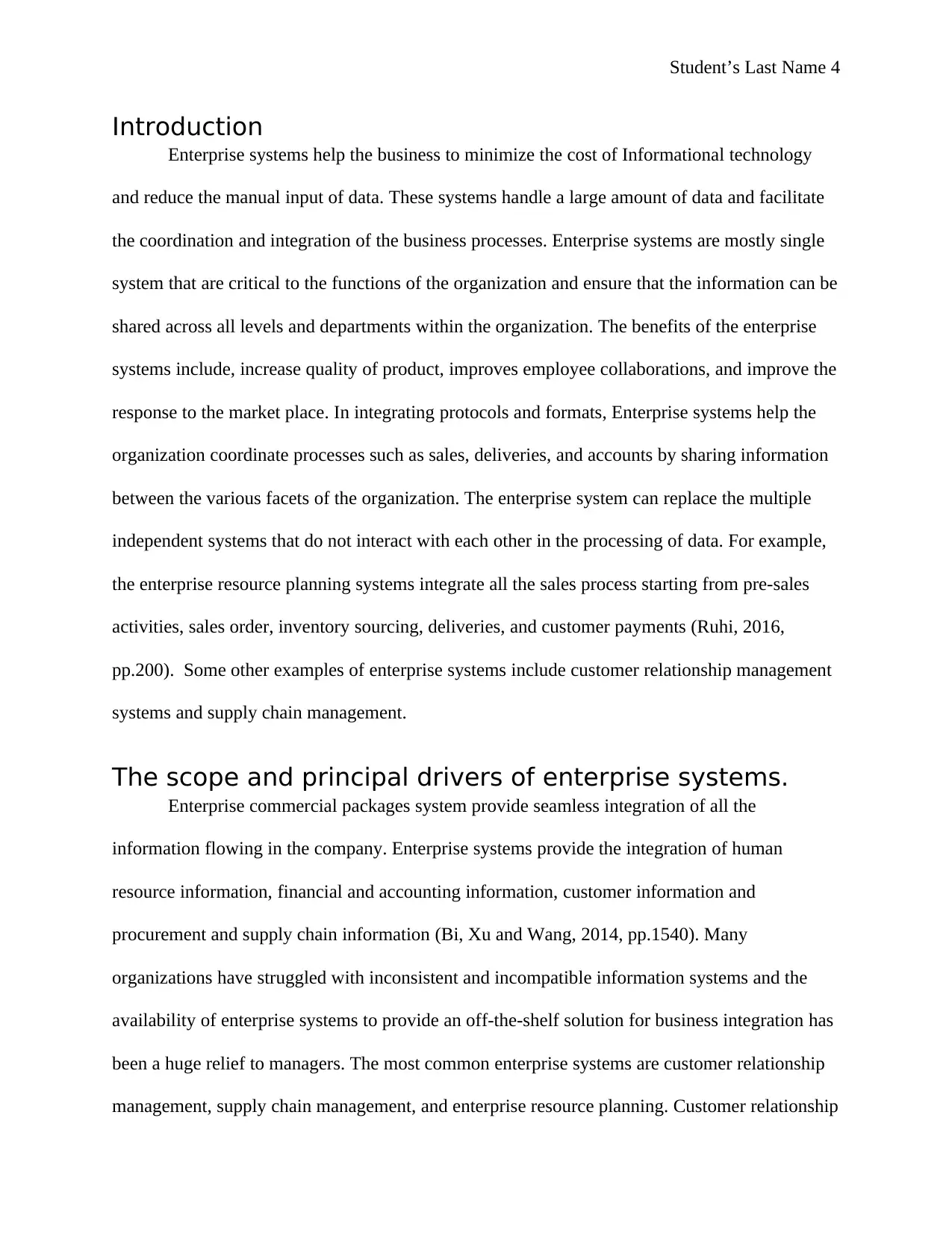
Student’s Last Name 4
Introduction
Enterprise systems help the business to minimize the cost of Informational technology
and reduce the manual input of data. These systems handle a large amount of data and facilitate
the coordination and integration of the business processes. Enterprise systems are mostly single
system that are critical to the functions of the organization and ensure that the information can be
shared across all levels and departments within the organization. The benefits of the enterprise
systems include, increase quality of product, improves employee collaborations, and improve the
response to the market place. In integrating protocols and formats, Enterprise systems help the
organization coordinate processes such as sales, deliveries, and accounts by sharing information
between the various facets of the organization. The enterprise system can replace the multiple
independent systems that do not interact with each other in the processing of data. For example,
the enterprise resource planning systems integrate all the sales process starting from pre-sales
activities, sales order, inventory sourcing, deliveries, and customer payments (Ruhi, 2016,
pp.200). Some other examples of enterprise systems include customer relationship management
systems and supply chain management.
The scope and principal drivers of enterprise systems.
Enterprise commercial packages system provide seamless integration of all the
information flowing in the company. Enterprise systems provide the integration of human
resource information, financial and accounting information, customer information and
procurement and supply chain information (Bi, Xu and Wang, 2014, pp.1540). Many
organizations have struggled with inconsistent and incompatible information systems and the
availability of enterprise systems to provide an off-the-shelf solution for business integration has
been a huge relief to managers. The most common enterprise systems are customer relationship
management, supply chain management, and enterprise resource planning. Customer relationship
Introduction
Enterprise systems help the business to minimize the cost of Informational technology
and reduce the manual input of data. These systems handle a large amount of data and facilitate
the coordination and integration of the business processes. Enterprise systems are mostly single
system that are critical to the functions of the organization and ensure that the information can be
shared across all levels and departments within the organization. The benefits of the enterprise
systems include, increase quality of product, improves employee collaborations, and improve the
response to the market place. In integrating protocols and formats, Enterprise systems help the
organization coordinate processes such as sales, deliveries, and accounts by sharing information
between the various facets of the organization. The enterprise system can replace the multiple
independent systems that do not interact with each other in the processing of data. For example,
the enterprise resource planning systems integrate all the sales process starting from pre-sales
activities, sales order, inventory sourcing, deliveries, and customer payments (Ruhi, 2016,
pp.200). Some other examples of enterprise systems include customer relationship management
systems and supply chain management.
The scope and principal drivers of enterprise systems.
Enterprise commercial packages system provide seamless integration of all the
information flowing in the company. Enterprise systems provide the integration of human
resource information, financial and accounting information, customer information and
procurement and supply chain information (Bi, Xu and Wang, 2014, pp.1540). Many
organizations have struggled with inconsistent and incompatible information systems and the
availability of enterprise systems to provide an off-the-shelf solution for business integration has
been a huge relief to managers. The most common enterprise systems are customer relationship
management, supply chain management, and enterprise resource planning. Customer relationship
Paraphrase This Document
Need a fresh take? Get an instant paraphrase of this document with our AI Paraphraser
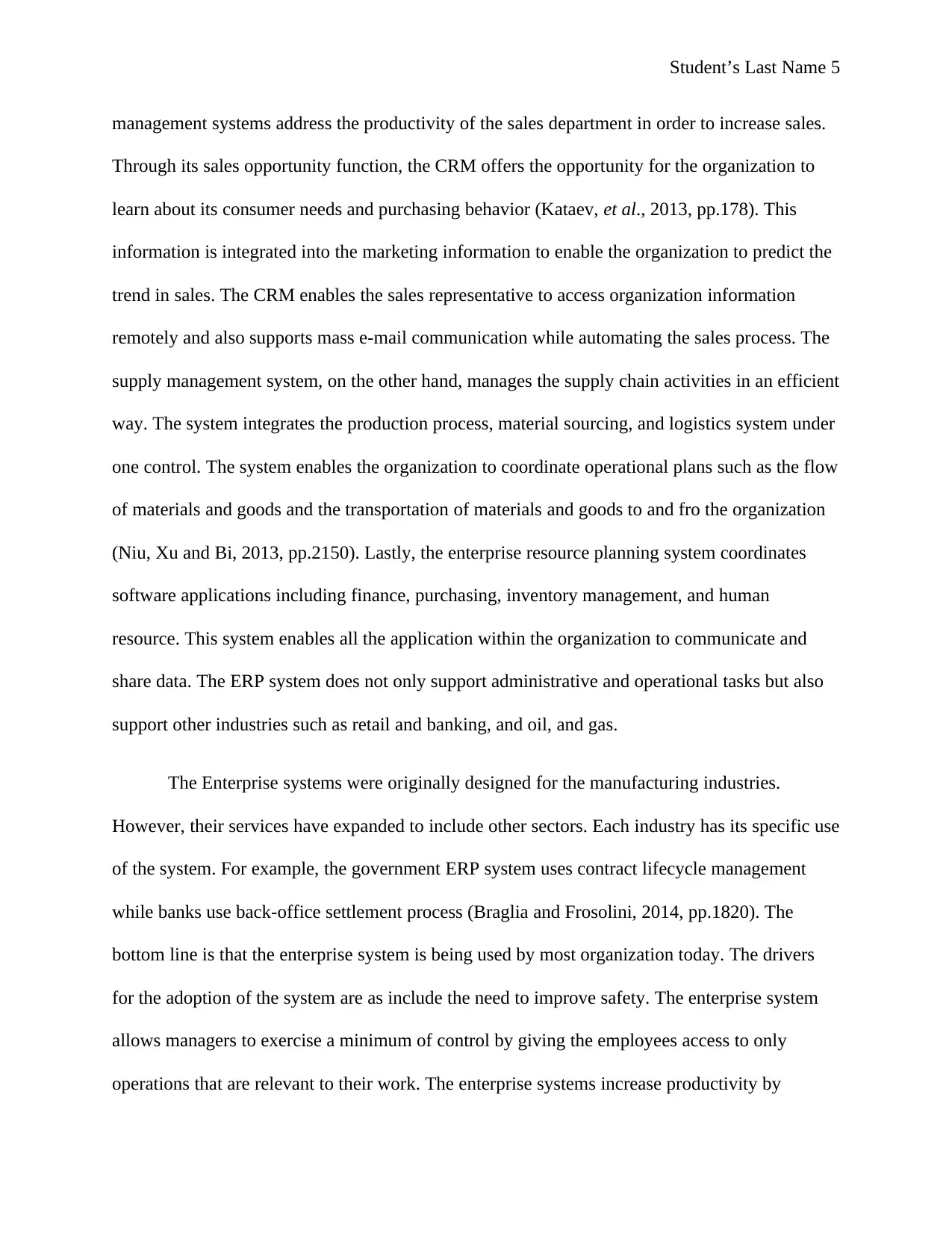
Student’s Last Name 5
management systems address the productivity of the sales department in order to increase sales.
Through its sales opportunity function, the CRM offers the opportunity for the organization to
learn about its consumer needs and purchasing behavior (Kataev, et al., 2013, pp.178). This
information is integrated into the marketing information to enable the organization to predict the
trend in sales. The CRM enables the sales representative to access organization information
remotely and also supports mass e-mail communication while automating the sales process. The
supply management system, on the other hand, manages the supply chain activities in an efficient
way. The system integrates the production process, material sourcing, and logistics system under
one control. The system enables the organization to coordinate operational plans such as the flow
of materials and goods and the transportation of materials and goods to and fro the organization
(Niu, Xu and Bi, 2013, pp.2150). Lastly, the enterprise resource planning system coordinates
software applications including finance, purchasing, inventory management, and human
resource. This system enables all the application within the organization to communicate and
share data. The ERP system does not only support administrative and operational tasks but also
support other industries such as retail and banking, and oil, and gas.
The Enterprise systems were originally designed for the manufacturing industries.
However, their services have expanded to include other sectors. Each industry has its specific use
of the system. For example, the government ERP system uses contract lifecycle management
while banks use back-office settlement process (Braglia and Frosolini, 2014, pp.1820). The
bottom line is that the enterprise system is being used by most organization today. The drivers
for the adoption of the system are as include the need to improve safety. The enterprise system
allows managers to exercise a minimum of control by giving the employees access to only
operations that are relevant to their work. The enterprise systems increase productivity by
management systems address the productivity of the sales department in order to increase sales.
Through its sales opportunity function, the CRM offers the opportunity for the organization to
learn about its consumer needs and purchasing behavior (Kataev, et al., 2013, pp.178). This
information is integrated into the marketing information to enable the organization to predict the
trend in sales. The CRM enables the sales representative to access organization information
remotely and also supports mass e-mail communication while automating the sales process. The
supply management system, on the other hand, manages the supply chain activities in an efficient
way. The system integrates the production process, material sourcing, and logistics system under
one control. The system enables the organization to coordinate operational plans such as the flow
of materials and goods and the transportation of materials and goods to and fro the organization
(Niu, Xu and Bi, 2013, pp.2150). Lastly, the enterprise resource planning system coordinates
software applications including finance, purchasing, inventory management, and human
resource. This system enables all the application within the organization to communicate and
share data. The ERP system does not only support administrative and operational tasks but also
support other industries such as retail and banking, and oil, and gas.
The Enterprise systems were originally designed for the manufacturing industries.
However, their services have expanded to include other sectors. Each industry has its specific use
of the system. For example, the government ERP system uses contract lifecycle management
while banks use back-office settlement process (Braglia and Frosolini, 2014, pp.1820). The
bottom line is that the enterprise system is being used by most organization today. The drivers
for the adoption of the system are as include the need to improve safety. The enterprise system
allows managers to exercise a minimum of control by giving the employees access to only
operations that are relevant to their work. The enterprise systems increase productivity by
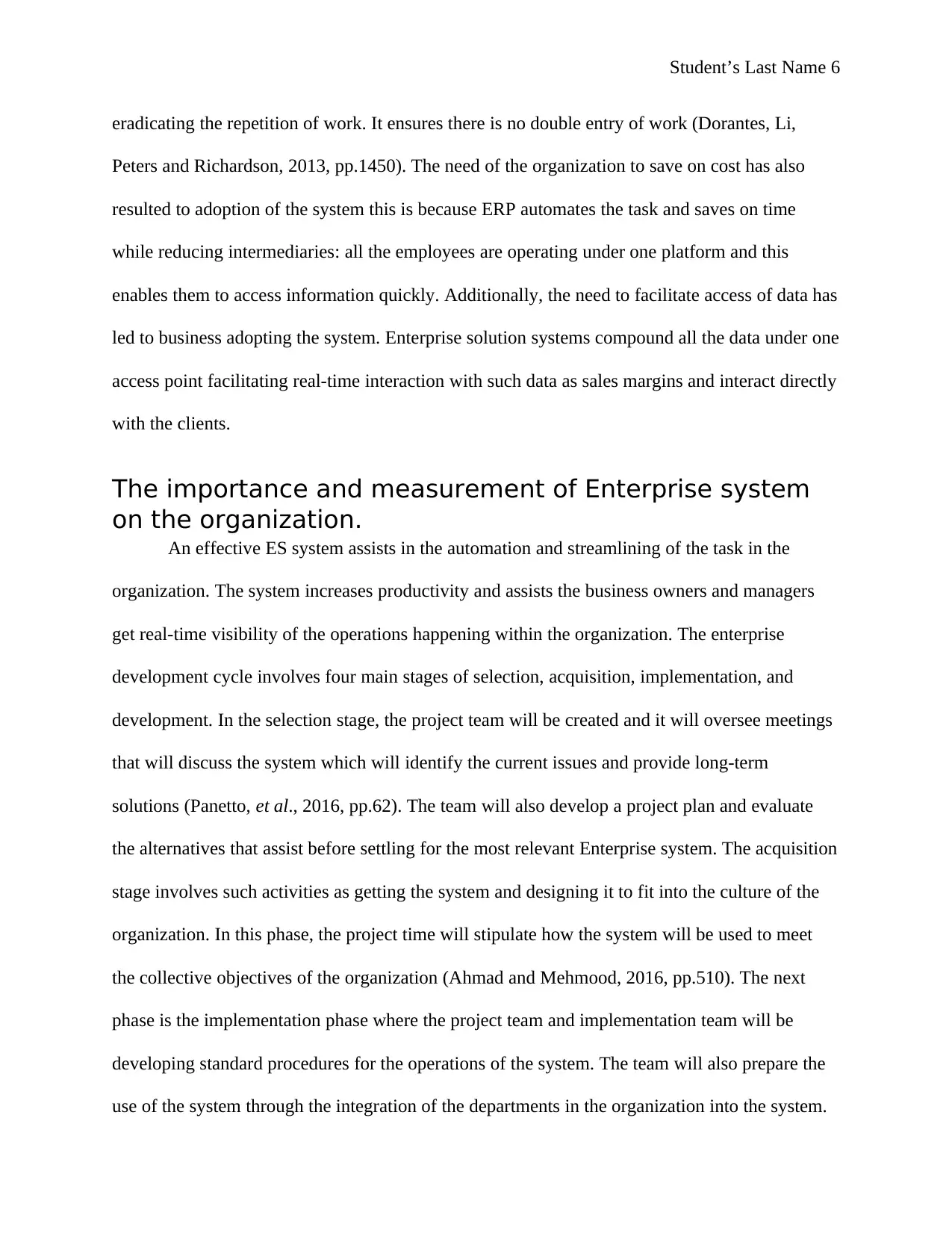
Student’s Last Name 6
eradicating the repetition of work. It ensures there is no double entry of work (Dorantes, Li,
Peters and Richardson, 2013, pp.1450). The need of the organization to save on cost has also
resulted to adoption of the system this is because ERP automates the task and saves on time
while reducing intermediaries: all the employees are operating under one platform and this
enables them to access information quickly. Additionally, the need to facilitate access of data has
led to business adopting the system. Enterprise solution systems compound all the data under one
access point facilitating real-time interaction with such data as sales margins and interact directly
with the clients.
The importance and measurement of Enterprise system
on the organization.
An effective ES system assists in the automation and streamlining of the task in the
organization. The system increases productivity and assists the business owners and managers
get real-time visibility of the operations happening within the organization. The enterprise
development cycle involves four main stages of selection, acquisition, implementation, and
development. In the selection stage, the project team will be created and it will oversee meetings
that will discuss the system which will identify the current issues and provide long-term
solutions (Panetto, et al., 2016, pp.62). The team will also develop a project plan and evaluate
the alternatives that assist before settling for the most relevant Enterprise system. The acquisition
stage involves such activities as getting the system and designing it to fit into the culture of the
organization. In this phase, the project time will stipulate how the system will be used to meet
the collective objectives of the organization (Ahmad and Mehmood, 2016, pp.510). The next
phase is the implementation phase where the project team and implementation team will be
developing standard procedures for the operations of the system. The team will also prepare the
use of the system through the integration of the departments in the organization into the system.
eradicating the repetition of work. It ensures there is no double entry of work (Dorantes, Li,
Peters and Richardson, 2013, pp.1450). The need of the organization to save on cost has also
resulted to adoption of the system this is because ERP automates the task and saves on time
while reducing intermediaries: all the employees are operating under one platform and this
enables them to access information quickly. Additionally, the need to facilitate access of data has
led to business adopting the system. Enterprise solution systems compound all the data under one
access point facilitating real-time interaction with such data as sales margins and interact directly
with the clients.
The importance and measurement of Enterprise system
on the organization.
An effective ES system assists in the automation and streamlining of the task in the
organization. The system increases productivity and assists the business owners and managers
get real-time visibility of the operations happening within the organization. The enterprise
development cycle involves four main stages of selection, acquisition, implementation, and
development. In the selection stage, the project team will be created and it will oversee meetings
that will discuss the system which will identify the current issues and provide long-term
solutions (Panetto, et al., 2016, pp.62). The team will also develop a project plan and evaluate
the alternatives that assist before settling for the most relevant Enterprise system. The acquisition
stage involves such activities as getting the system and designing it to fit into the culture of the
organization. In this phase, the project time will stipulate how the system will be used to meet
the collective objectives of the organization (Ahmad and Mehmood, 2016, pp.510). The next
phase is the implementation phase where the project team and implementation team will be
developing standard procedures for the operations of the system. The team will also prepare the
use of the system through the integration of the departments in the organization into the system.
⊘ This is a preview!⊘
Do you want full access?
Subscribe today to unlock all pages.

Trusted by 1+ million students worldwide
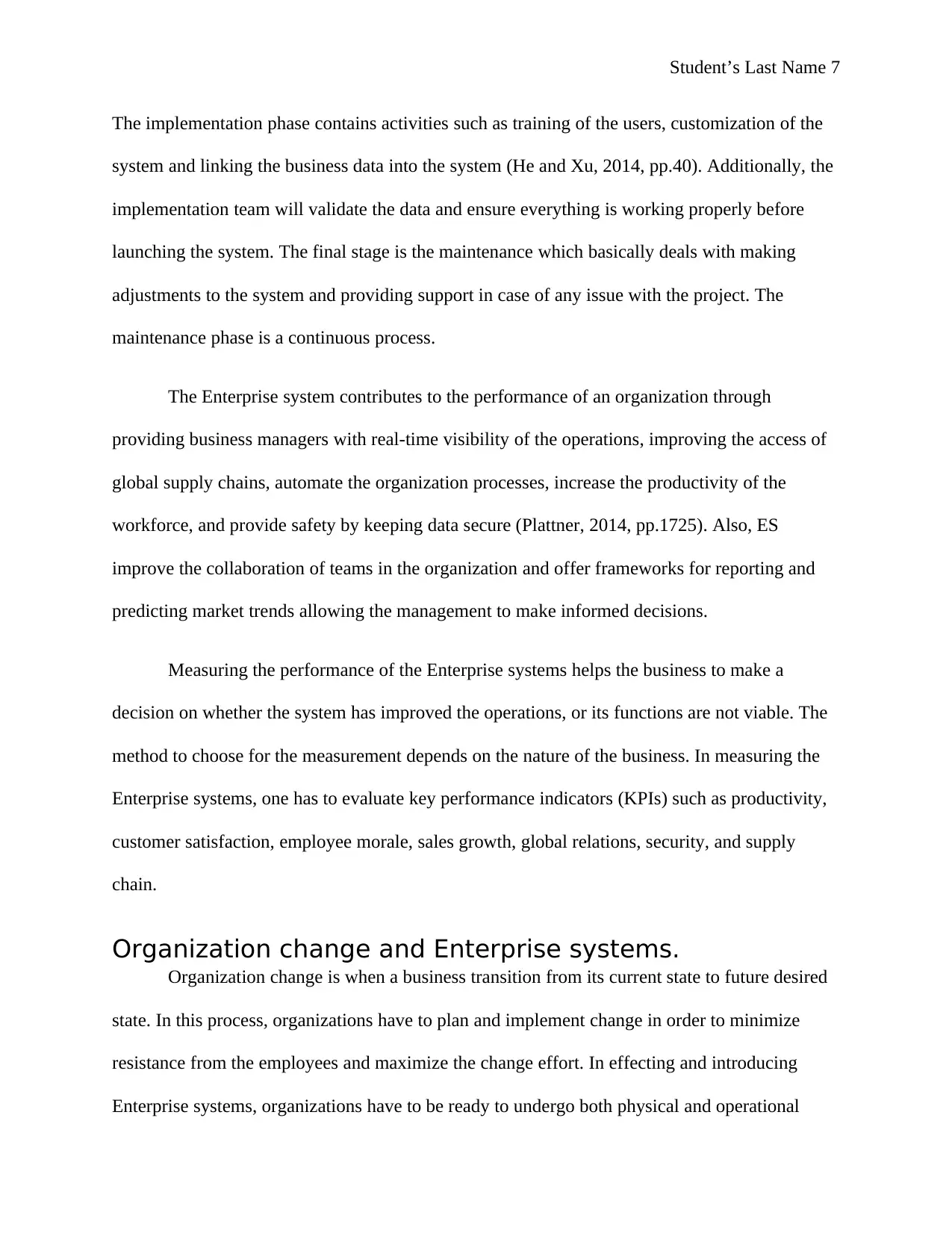
Student’s Last Name 7
The implementation phase contains activities such as training of the users, customization of the
system and linking the business data into the system (He and Xu, 2014, pp.40). Additionally, the
implementation team will validate the data and ensure everything is working properly before
launching the system. The final stage is the maintenance which basically deals with making
adjustments to the system and providing support in case of any issue with the project. The
maintenance phase is a continuous process.
The Enterprise system contributes to the performance of an organization through
providing business managers with real-time visibility of the operations, improving the access of
global supply chains, automate the organization processes, increase the productivity of the
workforce, and provide safety by keeping data secure (Plattner, 2014, pp.1725). Also, ES
improve the collaboration of teams in the organization and offer frameworks for reporting and
predicting market trends allowing the management to make informed decisions.
Measuring the performance of the Enterprise systems helps the business to make a
decision on whether the system has improved the operations, or its functions are not viable. The
method to choose for the measurement depends on the nature of the business. In measuring the
Enterprise systems, one has to evaluate key performance indicators (KPIs) such as productivity,
customer satisfaction, employee morale, sales growth, global relations, security, and supply
chain.
Organization change and Enterprise systems.
Organization change is when a business transition from its current state to future desired
state. In this process, organizations have to plan and implement change in order to minimize
resistance from the employees and maximize the change effort. In effecting and introducing
Enterprise systems, organizations have to be ready to undergo both physical and operational
The implementation phase contains activities such as training of the users, customization of the
system and linking the business data into the system (He and Xu, 2014, pp.40). Additionally, the
implementation team will validate the data and ensure everything is working properly before
launching the system. The final stage is the maintenance which basically deals with making
adjustments to the system and providing support in case of any issue with the project. The
maintenance phase is a continuous process.
The Enterprise system contributes to the performance of an organization through
providing business managers with real-time visibility of the operations, improving the access of
global supply chains, automate the organization processes, increase the productivity of the
workforce, and provide safety by keeping data secure (Plattner, 2014, pp.1725). Also, ES
improve the collaboration of teams in the organization and offer frameworks for reporting and
predicting market trends allowing the management to make informed decisions.
Measuring the performance of the Enterprise systems helps the business to make a
decision on whether the system has improved the operations, or its functions are not viable. The
method to choose for the measurement depends on the nature of the business. In measuring the
Enterprise systems, one has to evaluate key performance indicators (KPIs) such as productivity,
customer satisfaction, employee morale, sales growth, global relations, security, and supply
chain.
Organization change and Enterprise systems.
Organization change is when a business transition from its current state to future desired
state. In this process, organizations have to plan and implement change in order to minimize
resistance from the employees and maximize the change effort. In effecting and introducing
Enterprise systems, organizations have to be ready to undergo both physical and operational
Paraphrase This Document
Need a fresh take? Get an instant paraphrase of this document with our AI Paraphraser
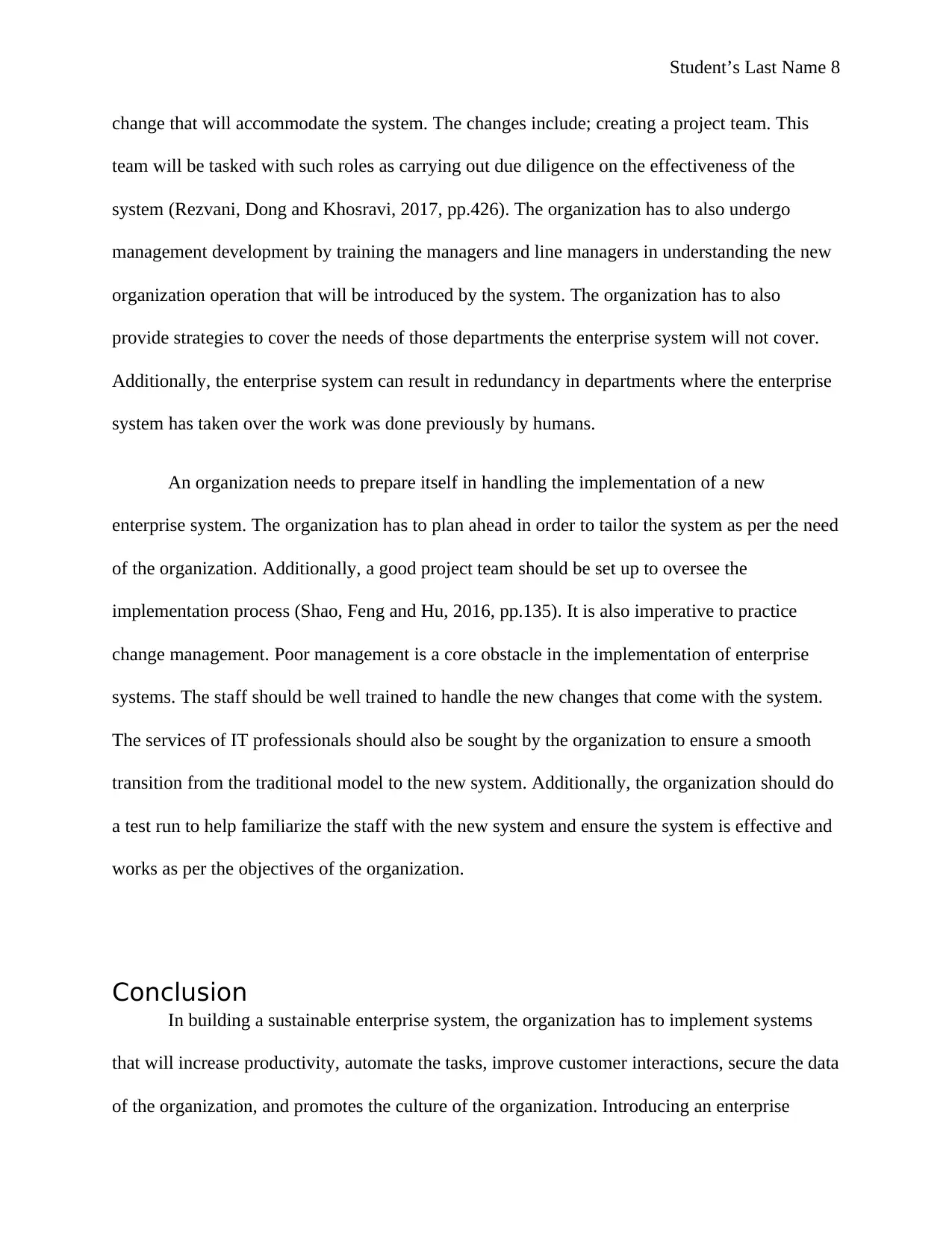
Student’s Last Name 8
change that will accommodate the system. The changes include; creating a project team. This
team will be tasked with such roles as carrying out due diligence on the effectiveness of the
system (Rezvani, Dong and Khosravi, 2017, pp.426). The organization has to also undergo
management development by training the managers and line managers in understanding the new
organization operation that will be introduced by the system. The organization has to also
provide strategies to cover the needs of those departments the enterprise system will not cover.
Additionally, the enterprise system can result in redundancy in departments where the enterprise
system has taken over the work was done previously by humans.
An organization needs to prepare itself in handling the implementation of a new
enterprise system. The organization has to plan ahead in order to tailor the system as per the need
of the organization. Additionally, a good project team should be set up to oversee the
implementation process (Shao, Feng and Hu, 2016, pp.135). It is also imperative to practice
change management. Poor management is a core obstacle in the implementation of enterprise
systems. The staff should be well trained to handle the new changes that come with the system.
The services of IT professionals should also be sought by the organization to ensure a smooth
transition from the traditional model to the new system. Additionally, the organization should do
a test run to help familiarize the staff with the new system and ensure the system is effective and
works as per the objectives of the organization.
Conclusion
In building a sustainable enterprise system, the organization has to implement systems
that will increase productivity, automate the tasks, improve customer interactions, secure the data
of the organization, and promotes the culture of the organization. Introducing an enterprise
change that will accommodate the system. The changes include; creating a project team. This
team will be tasked with such roles as carrying out due diligence on the effectiveness of the
system (Rezvani, Dong and Khosravi, 2017, pp.426). The organization has to also undergo
management development by training the managers and line managers in understanding the new
organization operation that will be introduced by the system. The organization has to also
provide strategies to cover the needs of those departments the enterprise system will not cover.
Additionally, the enterprise system can result in redundancy in departments where the enterprise
system has taken over the work was done previously by humans.
An organization needs to prepare itself in handling the implementation of a new
enterprise system. The organization has to plan ahead in order to tailor the system as per the need
of the organization. Additionally, a good project team should be set up to oversee the
implementation process (Shao, Feng and Hu, 2016, pp.135). It is also imperative to practice
change management. Poor management is a core obstacle in the implementation of enterprise
systems. The staff should be well trained to handle the new changes that come with the system.
The services of IT professionals should also be sought by the organization to ensure a smooth
transition from the traditional model to the new system. Additionally, the organization should do
a test run to help familiarize the staff with the new system and ensure the system is effective and
works as per the objectives of the organization.
Conclusion
In building a sustainable enterprise system, the organization has to implement systems
that will increase productivity, automate the tasks, improve customer interactions, secure the data
of the organization, and promotes the culture of the organization. Introducing an enterprise

Student’s Last Name 9
system is an investment for the future benefits of the organization. Therefore, there is a need for
the organization to ensure it chooses the right system and implement measures that will ensure
its smooth flow.
system is an investment for the future benefits of the organization. Therefore, there is a need for
the organization to ensure it chooses the right system and implement measures that will ensure
its smooth flow.
⊘ This is a preview!⊘
Do you want full access?
Subscribe today to unlock all pages.

Trusted by 1+ million students worldwide
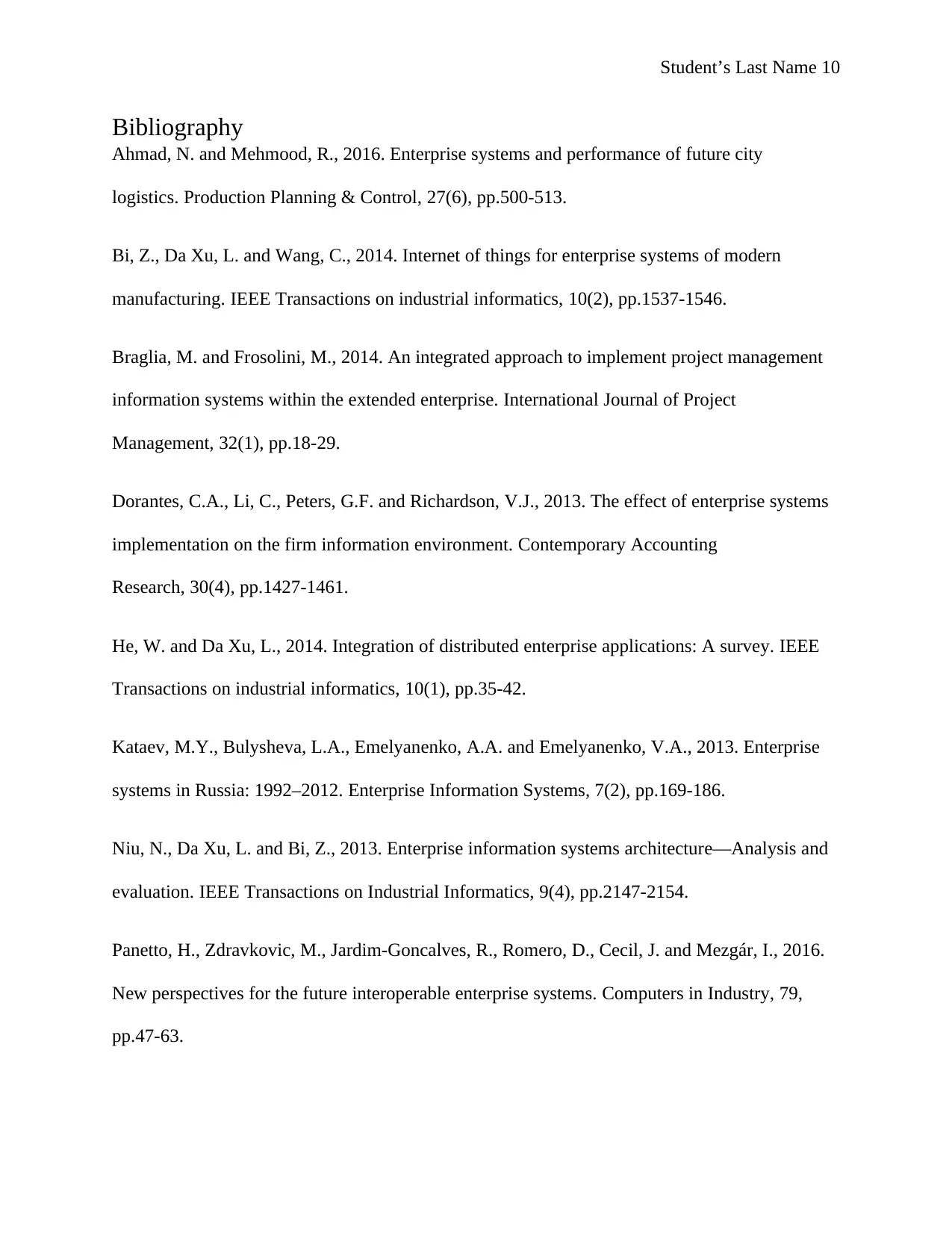
Student’s Last Name 10
Bibliography
Ahmad, N. and Mehmood, R., 2016. Enterprise systems and performance of future city
logistics. Production Planning & Control, 27(6), pp.500-513.
Bi, Z., Da Xu, L. and Wang, C., 2014. Internet of things for enterprise systems of modern
manufacturing. IEEE Transactions on industrial informatics, 10(2), pp.1537-1546.
Braglia, M. and Frosolini, M., 2014. An integrated approach to implement project management
information systems within the extended enterprise. International Journal of Project
Management, 32(1), pp.18-29.
Dorantes, C.A., Li, C., Peters, G.F. and Richardson, V.J., 2013. The effect of enterprise systems
implementation on the firm information environment. Contemporary Accounting
Research, 30(4), pp.1427-1461.
He, W. and Da Xu, L., 2014. Integration of distributed enterprise applications: A survey. IEEE
Transactions on industrial informatics, 10(1), pp.35-42.
Kataev, M.Y., Bulysheva, L.A., Emelyanenko, A.A. and Emelyanenko, V.A., 2013. Enterprise
systems in Russia: 1992–2012. Enterprise Information Systems, 7(2), pp.169-186.
Niu, N., Da Xu, L. and Bi, Z., 2013. Enterprise information systems architecture—Analysis and
evaluation. IEEE Transactions on Industrial Informatics, 9(4), pp.2147-2154.
Panetto, H., Zdravkovic, M., Jardim-Goncalves, R., Romero, D., Cecil, J. and Mezgár, I., 2016.
New perspectives for the future interoperable enterprise systems. Computers in Industry, 79,
pp.47-63.
Bibliography
Ahmad, N. and Mehmood, R., 2016. Enterprise systems and performance of future city
logistics. Production Planning & Control, 27(6), pp.500-513.
Bi, Z., Da Xu, L. and Wang, C., 2014. Internet of things for enterprise systems of modern
manufacturing. IEEE Transactions on industrial informatics, 10(2), pp.1537-1546.
Braglia, M. and Frosolini, M., 2014. An integrated approach to implement project management
information systems within the extended enterprise. International Journal of Project
Management, 32(1), pp.18-29.
Dorantes, C.A., Li, C., Peters, G.F. and Richardson, V.J., 2013. The effect of enterprise systems
implementation on the firm information environment. Contemporary Accounting
Research, 30(4), pp.1427-1461.
He, W. and Da Xu, L., 2014. Integration of distributed enterprise applications: A survey. IEEE
Transactions on industrial informatics, 10(1), pp.35-42.
Kataev, M.Y., Bulysheva, L.A., Emelyanenko, A.A. and Emelyanenko, V.A., 2013. Enterprise
systems in Russia: 1992–2012. Enterprise Information Systems, 7(2), pp.169-186.
Niu, N., Da Xu, L. and Bi, Z., 2013. Enterprise information systems architecture—Analysis and
evaluation. IEEE Transactions on Industrial Informatics, 9(4), pp.2147-2154.
Panetto, H., Zdravkovic, M., Jardim-Goncalves, R., Romero, D., Cecil, J. and Mezgár, I., 2016.
New perspectives for the future interoperable enterprise systems. Computers in Industry, 79,
pp.47-63.
Paraphrase This Document
Need a fresh take? Get an instant paraphrase of this document with our AI Paraphraser
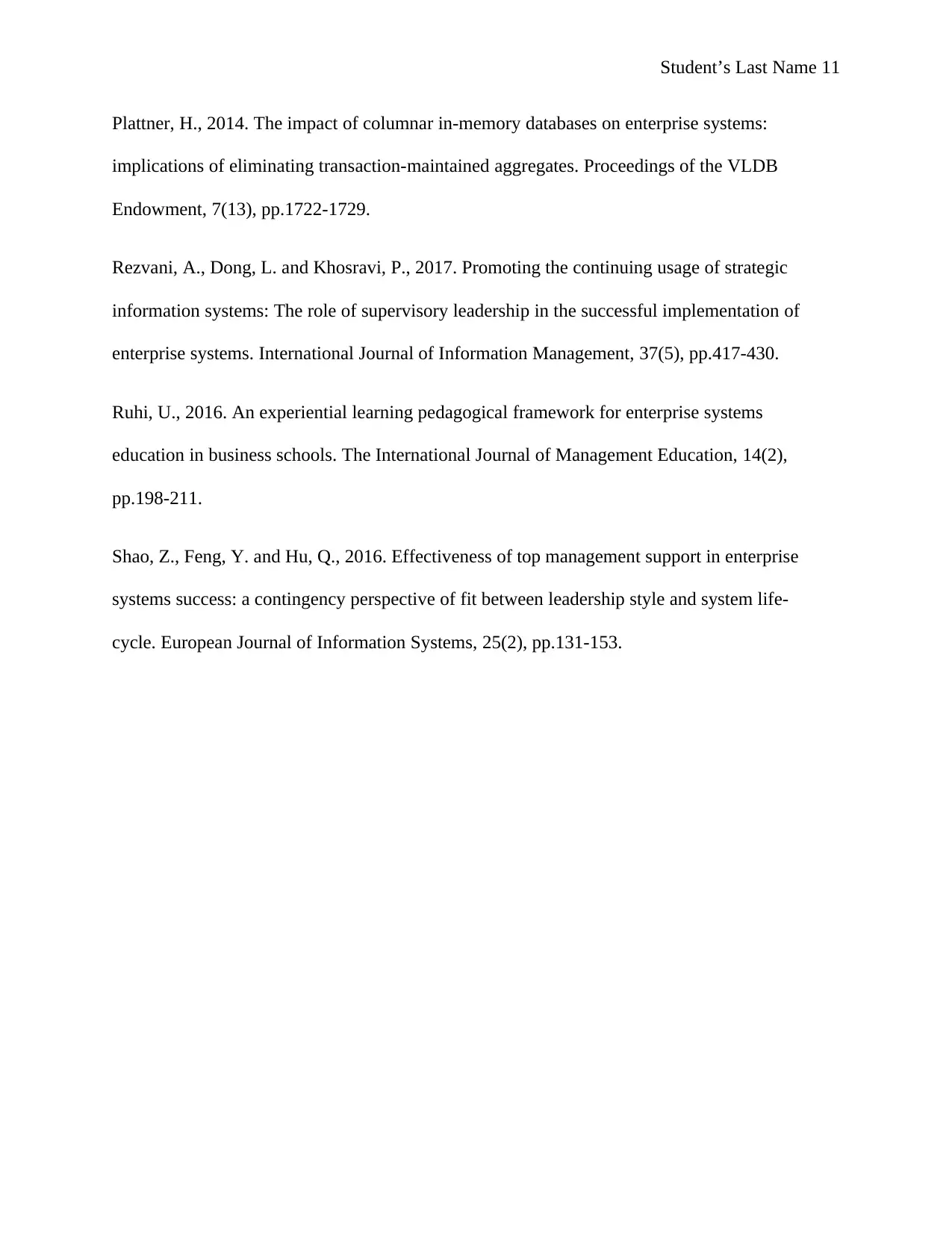
Student’s Last Name 11
Plattner, H., 2014. The impact of columnar in-memory databases on enterprise systems:
implications of eliminating transaction-maintained aggregates. Proceedings of the VLDB
Endowment, 7(13), pp.1722-1729.
Rezvani, A., Dong, L. and Khosravi, P., 2017. Promoting the continuing usage of strategic
information systems: The role of supervisory leadership in the successful implementation of
enterprise systems. International Journal of Information Management, 37(5), pp.417-430.
Ruhi, U., 2016. An experiential learning pedagogical framework for enterprise systems
education in business schools. The International Journal of Management Education, 14(2),
pp.198-211.
Shao, Z., Feng, Y. and Hu, Q., 2016. Effectiveness of top management support in enterprise
systems success: a contingency perspective of fit between leadership style and system life-
cycle. European Journal of Information Systems, 25(2), pp.131-153.
Plattner, H., 2014. The impact of columnar in-memory databases on enterprise systems:
implications of eliminating transaction-maintained aggregates. Proceedings of the VLDB
Endowment, 7(13), pp.1722-1729.
Rezvani, A., Dong, L. and Khosravi, P., 2017. Promoting the continuing usage of strategic
information systems: The role of supervisory leadership in the successful implementation of
enterprise systems. International Journal of Information Management, 37(5), pp.417-430.
Ruhi, U., 2016. An experiential learning pedagogical framework for enterprise systems
education in business schools. The International Journal of Management Education, 14(2),
pp.198-211.
Shao, Z., Feng, Y. and Hu, Q., 2016. Effectiveness of top management support in enterprise
systems success: a contingency perspective of fit between leadership style and system life-
cycle. European Journal of Information Systems, 25(2), pp.131-153.
1 out of 11
Related Documents
Your All-in-One AI-Powered Toolkit for Academic Success.
+13062052269
info@desklib.com
Available 24*7 on WhatsApp / Email
![[object Object]](/_next/static/media/star-bottom.7253800d.svg)
Unlock your academic potential
Copyright © 2020–2025 A2Z Services. All Rights Reserved. Developed and managed by ZUCOL.





